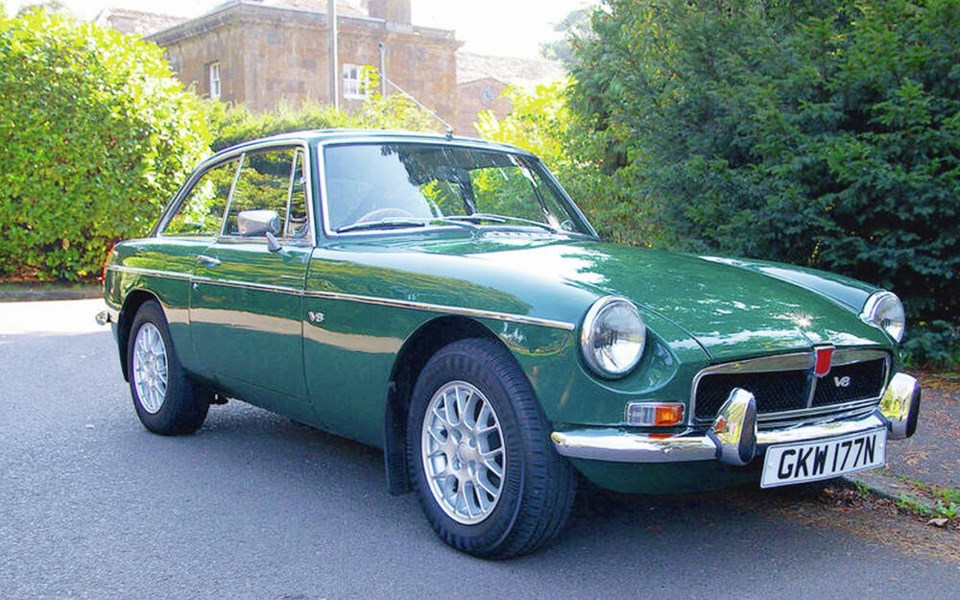When th British MG was imported to North America following the Second World War it immediately became the quintessential sports car, the definition of the genre. First to arrive was the classically styled square-cut, spider-wheeled MG TC. It was followed by the evolutionary somewhat modernized TD and TF, then the modern envelope bodied A and B models. But while the MG was the quintessential sports car, its performance was modest.
The TC and TD could barely break 80 mph (129 km/h) and the TF wasn’t much faster. It took until 1957 for the MGA Coupe to achieve the magical 100 mph (161 km/h). Competitors like Triumph, Austin-Healey and Morgan easily outran it.
The MGA was replaced by the MGB roadster for 1963, joined in 1965 by the MGB GT, a sporty hatchback coupe version with room for a couple of (very) small passengers in the rear. With styling inspired by Italy’s Pinanfarina it provided a roadster’s performance with a closed car’s comfort.
After struggling for two years with the poor selling MGC fitted with an Austin 3.0 litre six, MG’s parent British Leland decided a better power and performance combination would be the GT with a Daimler V-8. It didn’t get past the prototype stage.
This didn’t deter privateer Ken Costello, engineer/operator of Costello Motor Engineering in Kent, from doing his own experiments. He was impressed by the quietness, power and light weight of Rover’s 3.5 litre V-8.
The overhead valve aluminum V-8 had been designed by General Motors and introduced in the 1961 Buick Special and Oldsmobile F-85 intermediates. GM soon realized that a cast iron V-6 was cheaper to build and offered about the same performance so it sold the V-8 to the Rover Co. who used it in Rover cars and Land Rover/Range Rover utility vehicles. It would also power the Morgan Plus-8 and Triumph TR8.
In 1970 Costello bought a V-8 engine from Rover and fitted it to an MGB GT, creating his own MGB GT V-8. Performance, as expected, was outstanding, and even though Costello did almost no advertising, his shop was soon turning out one GT V-8 a week. An unexpected bonus was that the V-8 engine was lighter than the 1.8 litre MG four.
This soon came to the attention of British Leyland, the corporate home of Rover and MG. A little embarrassed that Costello had successfully achieved what they had abandoned, they evaluated Costello’s GT V-8 and ordered their engineers to begin experimenting with the Rover V-8 in the MGB GT.
At the same time, not surprisingly, Costello’s source of new V-8s began to dry up. The resourceful engineer managed to scrounge and rebuild enough used ones to keep his GT V-8s going for two more years.
MG engineers modified the V-8 to fit into the smaller space, including designing revised exhaust and intake manifolds that placed the twin SU carburetors at the rear of the engine. The fit under the GT hood was so snug that it required small circles to be cut out of the hood’s insulating pad to accommodate the tops of the carburetors!
Power went through a four-speed all synchromesh manual transmission fitted with electric overdrive that operated on fourth gear. This gave a long-legged overall ratio of 2.52:1 that allowed the engine to turn a lazy 2,100 rpm at 97 km/h (60 mph). Suspension was the usual MGB A-arms with front coil springs, and leaf springs with beam axle at the rear. Steering was rack-and-pinion.
BL introduced the MGB GT V-8 in 1973 and the only external differences from the four cylinder model were alloy wheels, larger tires and V-8 badging. Performance of the 1,089 kg (2,400 lb) hatchback was sensational, as would be expected with the (SAE net) horsepower increased from 79 to 131.
Even more important, torque was increased from 94 to 185 lb ft. Britain’s Motor magazine reported zero to 60 mph (97 km/h) in 7.7 seconds and top speed of 125 mph (200 km/h). While impressed with the outstanding performance, the testers opined that the aging MG chassis lacked refinement.
The handling, style and dash of an English sports car wedded to smooth American V-8 power would likely have enjoyed popularity in North America but the GT V-8 was not imported. BL considered it, but decided the cost of meeting safety and emissions legislation would be prohibitive.
The MGB GT V-8 was manufactured from 1973 to 1976, with a total of 2,591 built. Production would no doubt have been higher except for a relatively high price and a chassis that was becoming dated.
It was another example of combining American power with an English chassis in the tradition of cars like Hudson Railtons, Cadillac Allards and Sunbeam Tigers. A few MGB GT V-8s have reached North America.



